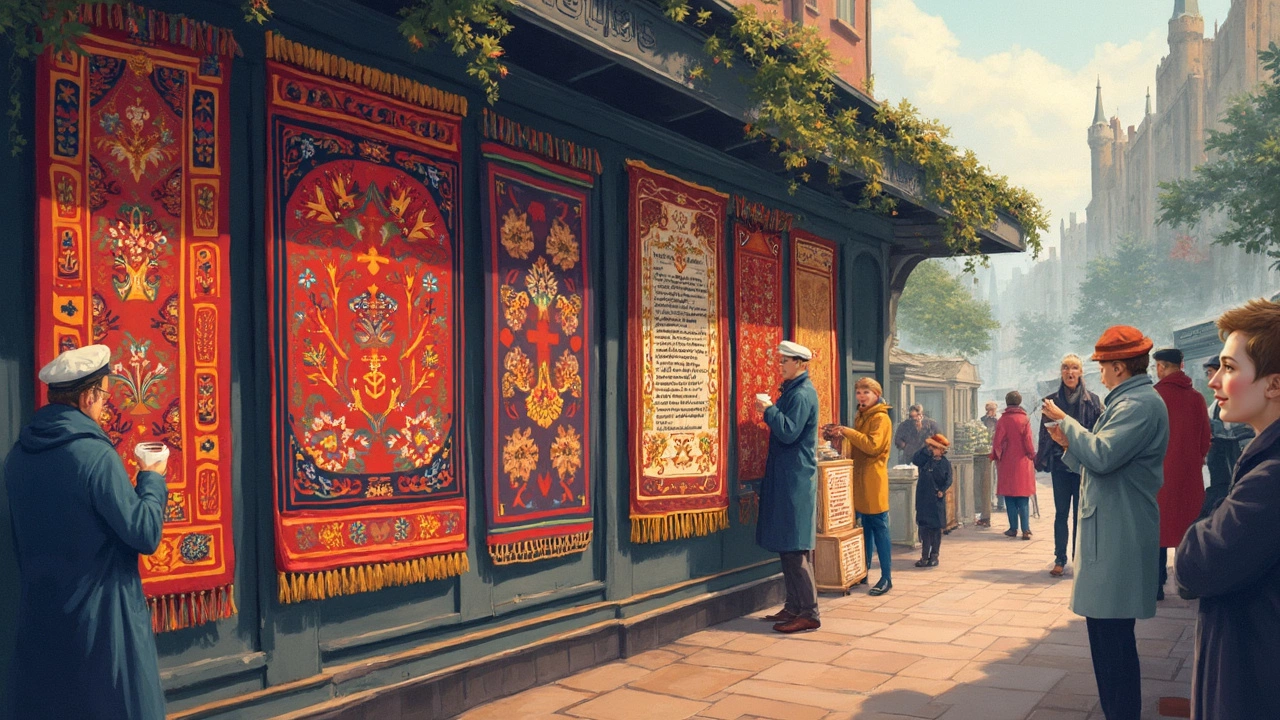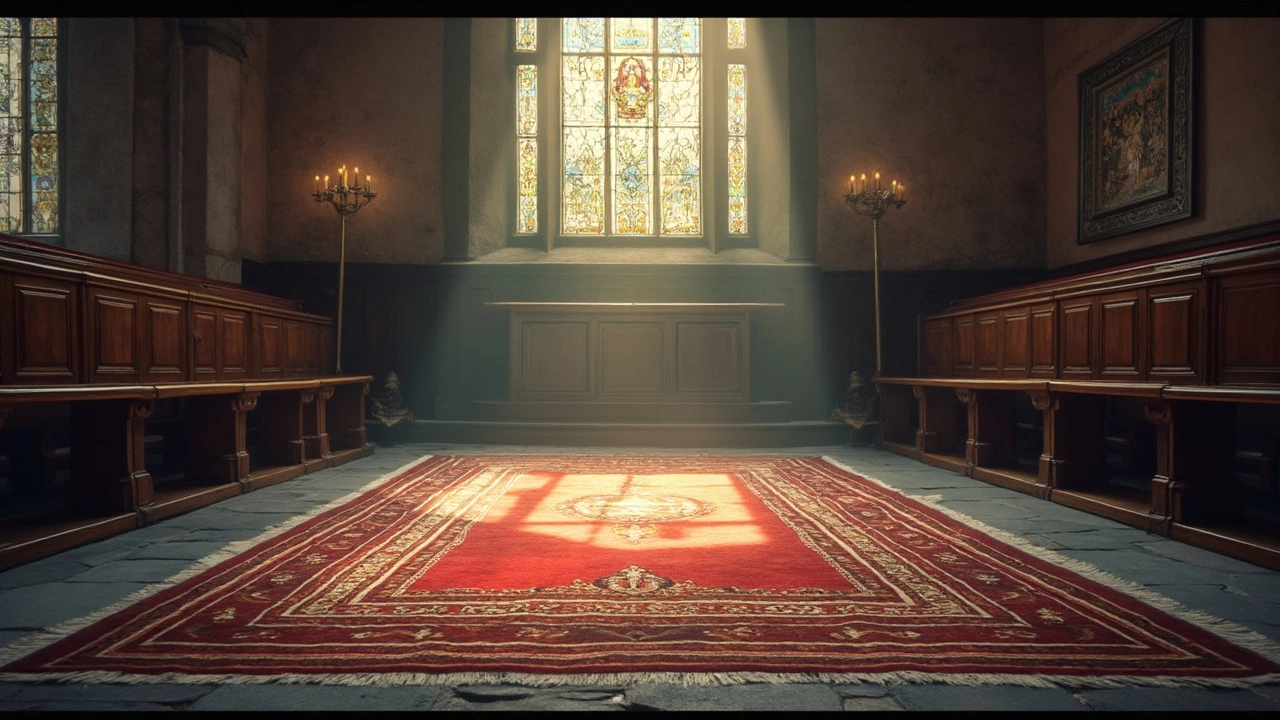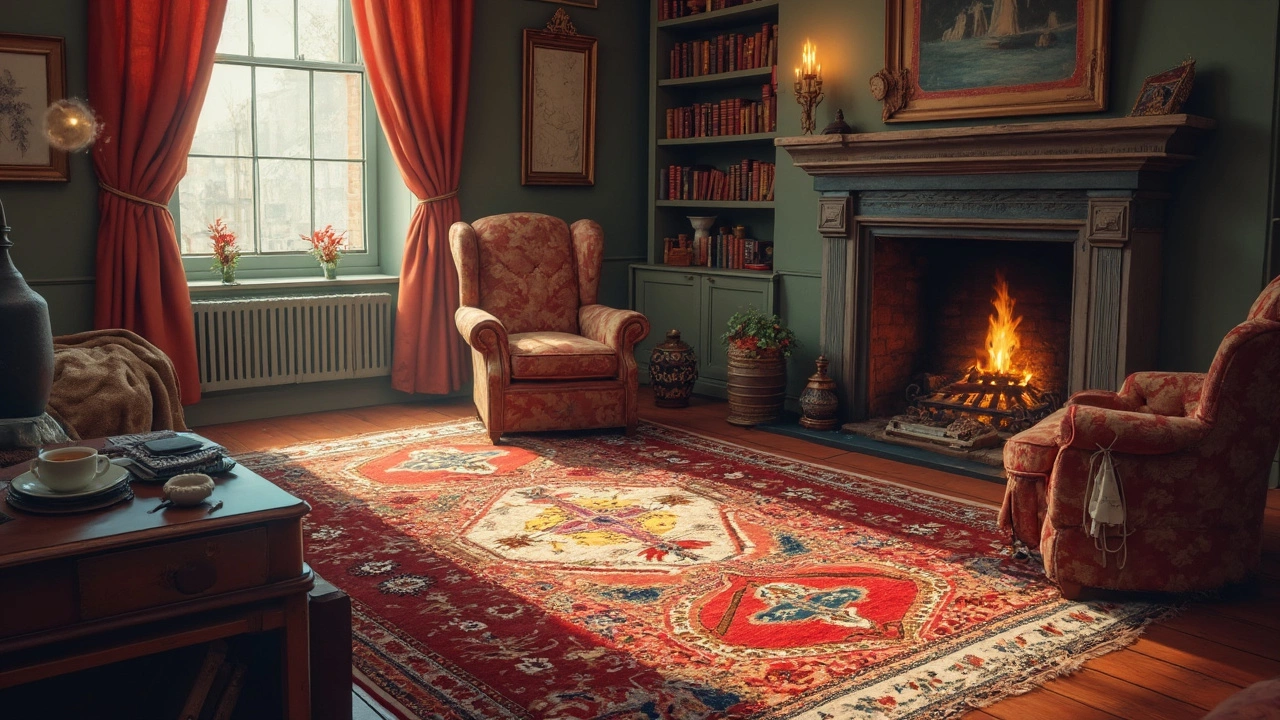So, you're staring at a rug and wondering if there's more to it than meets the eye. Ever heard of prayer rugs? They're not just any rug; they've got a whole story woven into them. First thing you check is that there's usually a niche or arch-like design at one end called a 'mihrab.' This isn't just for show—it's a key feature!
Prayer rugs are filled with symbols. Look for things like a tree of life or a mosque lamp. These aren't random decorations; they serve a spiritual purpose. And the direction matters. Many prayer rugs aim to guide users towards Mecca.
These rugs aren't merely functional. They're steeped in cultural significance. They're more than wool and pattern—they're respect, dedication, and a touch of artistry. Stick around, and you'll be able to spot a prayer rug like a pro!
- Recognizing Sacred Symbols
- Directional Features Explained
- Cultural Significance
- Practical Uses in Daily Life
- Tips for Rug Collectors
Recognizing Sacred Symbols
When it comes to identifying a prayer rug, the sacred symbols woven into it are a dead giveaway. These motifs aren't casual decorations; they hold deep religious significance that guides their use in worship.
The Mihrab Pattern
The most prominent feature is the mihrab design, resembling an arch, like those found in mosques directing attention towards Mecca. It’s a crucial feature on authentic prayer rugs because it's the spot where the person places their head during prayers.
Symbolic Motifs
Beyond the mihrab, you might notice other motifs like the ‘Tree of Life,’ which signifies everlasting life, or a ‘Mosque Lamp,’ which hints at divine light. Sometimes there are water jugs, which symbolize purification and cleanliness, vital aspects in many religious practices.
Some traditional rugs feature geometric shapes and floral patterns, but the key difference with prayer rugs is these elements hold symbolic resonance. They're meant to create a spiritual atmosphere, transforming a simple floor covering into a pathway for prayer.
Colors and Their Meanings
Colors on prayer rugs aren't just for aesthetics. Blue often represents spirituality, red might stand for courage and passion, while green is frequently associated with paradise. These colors together form a palette that enhances the symbolic journey during prayers.
Knowing these sacred symbols not only helps you identify a true prayer rug but also lets you appreciate the depth of cultural and spiritual artistry. It's about understanding more than just the threads and patterns—it's about connecting to a rich tapestry of traditions.
Directional Features Explained
Alright, let's unravel why direction matters so much in a prayer rug. First off, it's all about the orientation towards Mecca, the holiest city for Muslims. How do you know which way the rug is oriented? It's in the design details!
Most prayer rugs have a top end that features a 'mihrab' design—a bit like an archway or niche. This is not just any pattern; it's meant to point towards Mecca during prayer. This design element is more than decorative and serves as a spiritual guide.
Characteristics to Look For
- Mihrab Design: Typically found at the top of the rug, indicating the qibla, or the direction of Mecca. It's what gives the rug its directional purpose.
- Symmetry and Borders: While the mihrab is on one side, the bottom half of the rug may have more geometric patterns. The borders that surround these designs further enhance orientation.
- Placement in Homes: Lots of households strategically place prayer rugs in rooms, facing the qibla. Isn't that neat?
The directional aspect isn't just a quirk; it's a consideration built into the design to help those performing prayer to easily find their focus. Understanding these nuances in traditional rugs can enrich your appreciation of this practical yet spiritual art form.

Cultural Significance
Prayer rugs aren't just floor coverings—they're steeped in rich cultural layers. In many Muslim households, prayer rugs serve a dual purpose. Not only do they provide a clean space for prayer, but they also represent a deep spiritual connection. When you think about it, this small piece of fabric often carries generations of tradition on its back.
The Role of Beauty and Art
Did you know that the artistry in these rugs isn't just about looking pretty? They play a teaching role, too. Take the Tree of Life motif as an example. This design symbolizes eternal life—a concept closely tied to religious teachings. It's art and spirituality knitted together!
Regional Variations
The style and design of a prayer rug can tell you a lot about its origin. In places like Turkey, for example, you'll find rugs with bold geometric patterns. Meanwhile, Persian rugs often focus on intricate floral designs. These aren’t mere aesthetic choices—each pattern represents the local culture and history.
A Cultural Reflection
Beyond religious use, prayer rugs also reflect the larger cultural tapestry of Muslim societies. They’re often given as gifts during special occasions, like weddings or significant religious milestones, symbolizing a wish for prosperity and spiritual growth. In that sense, these rugs serve as cultural markers.
Each time you lay down a prayer rug, you're unrolling a bit of history, culture, and spirituality, all woven into one. Isn't that fascinating?
Practical Uses in Daily Life
Every day, these prayer rugs play a significant role beyond their religious purpose. For starters, they're an excellent example of how necessity meets tradition, especially in traditional rugs design. When it comes to everyday use, their practical features shine through in multiple aspects.
Cleanliness and Comfort
Picture this: you're getting ready to pray, but the floor is cold or maybe not as clean as you'd like. That's where the prayer rug comes in. These rugs provide a clean and comfortable spot to pray, which is pretty vital. Let's face it, no one wants to kneel on a hard, cold floor during prayer.
Portable and Convenient
Another perk? They're super portable. Most prayer rugs are lightweight and easy to fold up. You can take your rug to the mosque, on trips, or even just move around the house with it. They usually fit into bags or backpacks without hassle.
Cultural Decor Element
Beyond practical use, they can be showcased as an elegant decor piece in homes. Because these rugs often feature intricate designs, they can complement your home decor really well. Plus, they always carry an added layer of cultural richness.
In Islamic customs, having one's own prayer rug is somewhat personal — like owning a cherished book. So, while they're mainly for prayer, they do carry personal, emotional significance too.

Tips for Rug Collectors
Thinking of diving into the rug-collecting world? Great choice! But it can be tricky figuring out if you're looking at a genuine prayer rug. Let's make sure you know what to look out for.
Know Your Sources
First up, always buy from reputable dealers. Whether it's a well-known shop or a respected online platform, make sure they have a solid track record. Trustworthy sources often provide documentation or at least detailed information about the rug’s origin, so you'll know it's the real deal.
Inspect the Material
These rugs are traditionally made from high-quality wool, so pay attention to the texture. They should feel soft yet durable. If it seems too synthetic or flimsy, it might not be authentic.
Check the Design
Authentic prayer rugs feature distinct symbols like the iconic mihrab. Look closely at the designs—they should not only be symmetrical but also deeply rooted in traditional motifs. These aren’t just decorative; they serve a purpose.
Consider Age and Condition
Older rugs often have more character and history, but watch out for excessive wear. A few signs of aging are okay, but if it’s falling apart, it might not be a wise investment. Strike a balance between charm and condition.
Price Points and Value
Prayer rugs can range from affordable to luxurious. Don’t get dazzled by high prices alone. Compare similar items to ensure you're getting good value. Sometimes the story behind a rug can add to its worth, not just the material.
- Research the average price of prayer rugs from specific regions.
- Consider if the rug’s unique features warrant a higher price.
- Think about the appreciation value if you're investing long-term.
Becoming a collector is as much about instinct as it is about knowledge. Trust your gut, but make sure it’s informed by facts. With these tips, you'll master the art of identifying and valuing a prayer rug in no time!

